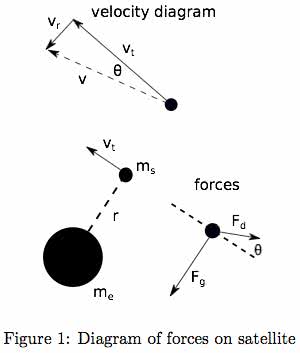PHYS 2001 Lecture Notes - Lecture 8: Inverse-Square Law, Nhindustries Nh90, Fundamental Interaction

The moon moves in a nearly perfect circle around the earth.
Since it’s moving in a circle, its
velocity is changing.
v
Since its velocity is changing, there
must be an acceleration.
vSince there is an acceleration, there
must be a force.
The same force that pulls the apple
v
toward the earth must also pull the
moon toward the earth.
This is the Gravitational Force.
v
If gravity didn’t pull on the moon it would continue to move in a straight line
If
gravity
didn’t
pull
on
the
moon
,
it
would
continue
to
move
in
a
straight
line
.
The gravitational force from
the earth pulls the moon
the
earth
pulls
the
moon
away from its straight-line
motion.
find more resources at oneclass.com
find more resources at oneclass.com

Newton’s Universal Law of Gravitation:
So How do you calculate the gravitational force between two objects?
21mm
G
F
=
Let’s consider two objects with masses m1and m2, and separate them by
some distance r:
m1
m2
r
Th
-
F
F
x2
r
G
F
=
Notice that the force is directly proportional to the product of the masses of the
t o objects and in ersel proportional to the sq are of the distance bet een
r
Th
en,
t
w
o
objects
and
in
v
ersel
y
proportional
to
the
sq
u
are
of
the
distance
bet
w
een
them.
The gravitational force equation is called an inverse square law. Nature
(ris the distance between the centers of each mass.)
loves inverse square laws, and we will encounter them again.
Gis the universal gravitational constant:2
2
k
g
mN
⋅
×= −11
1067259.6G
g
Properties of Newton’s Law of Gravitation:
1. It grows weaker with distance.
2It t t f i i
Note: The forces on the
two masses are equal but
opposite as dictated by
2
.
It
ge
t
s s
t
ronger
f
or
i
ncreas
i
ng masses.
4. It’s directed along the line containing the two masses.
opposite
as
dictated
by
Newton’s 3rd Law!
3. It is always attractive.
D
find more resources at oneclass.com
find more resources at oneclass.com

What is the acceleration of a tennis ball falling near the surface of the earth?
It’s – 9.8 m/s2
,
but wh
y
???
Mass of the ball
Mass of the earth
,y
2
E
EB
r
mm
GF =
We can calculate the force on the ball:
Mass
of
the
ball
Mass
of
the
earth
E
r
Radius of the earth
But we can also write the force on the ball using Newton
’
s2
nd
Law:
a
m
F
B
=
But
we
can
also
write
the
force
on
the
ball
using
Newton s
2
Law:
a
m
F
B
These two forces have to be equal: 2
E
EB
Br
mm
Gam =
2
E
E
r
m
Ga =This must be the acceleration of the ball. Let’s calculate it:
242
11
k
g)
1098.5
(
)
mN
10
67
6
(
×
⋅
−
2
/
8
9
COOL!
26
11
m) 10(6.38
g)
(
)
kg
10
67
.
6
(
×
×
=
a
g
=
=
2
m
/
s
8
.
9
COOL!
Thus the acceleration due to gravity depends on the mass of the earth and
Thus
,
the
acceleration
due
to
gravity
depends
on
the
mass
of
the
earth
and
the distance I am from the earth’s center. If I’m standing on the earth’s
surface, then this distance is just the radius of the earth.
find more resources at oneclass.com
find more resources at oneclass.com
Document Summary
The moon moves in a nearly perfect circle around the earth. v v. Since it"s moving in a circle, its velocity is changing. Since its velocity is changing, there must be an acceleration. v. Since there is an acceleration, there must be a force. The same force that pulls the apple toward the earth must also pull the moon toward the earth. If gravity didn"t pull on the moon it would continue to move in a straight line. If gravity didn"t pull on the moon, it would continue to move in a straight line. v. The gravitational force from the earth pulls the moon the earth pulls the moon away from its straight-line motion. Let"s consider two objects with masses m1 and m2, and separate them by some distance r: m1 m2. The gravitational force equation is called an inverse square law. Nature loves inverse square laws, and we will encounter them again. 2: it gets stronger for increasing masses.


